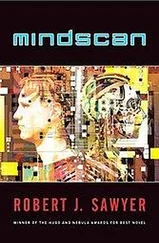Ponter headed out into the main room of the house. Pabo immediately bounded over to him. Ponter reached down and scratched the top of the dog’s head. “Don’t worry, girl,” he said. “I haven’t forgotten you.”
He opened the vacuum box and pulled out a large, meaty bison bone, saved from last night’s dinner. He then set it on the floor—the moss overlain with glass sheets here to make cleanups easier—and Pabo began to gnaw at it. Adikor joined Ponter in the kitchen and set about fixing breakfast. He took two slabs of elk meat out of the vacuum box and put them in the laser cooker, which filled with steam to remoisturize the meat. Ponter glanced over, looking through the cooker’s window, watching the ruby beams crisscrossing in intricate patterns, perfectly grilling every part of the steaks. Adikor filled a bowl with pine nuts and set out mugs of diluted maple syrup, then fetched the now-done steaks.
Ponter turned on the Voyeur, the square wall-mounted panel springing instantly to life. The screen was divided into four smaller squares, one showing transmissions from Hawst’s enhanced Companion; another, those from Talok’s; the lower-left, pictures of Gawlt’s life; and the lower-right, images of Lulasm’s. Adikor, Ponter knew, was a Hawst fan, so he told the Voyeur to expand that image to fill the entire screen. Ponter had to admit that Hawst was always up to something interesting—this morning, he’d headed to the outskirts of Saldak where five people had been buried alive by a rockslide. Still, if an Exhibitionist did come by the mineshaft entrance today, Ponter hoped it would be Lulasm; Ponter thought she usually asked the most insightful questions.
Ponter and Adikor both sat and put on dining gloves. Adikor scooped up some pine nuts from the bowl and sprinkled them over his steak, then pounded them into the meat with the palm of his gloved hand. Ponter smiled; it was one of Adikor’s endearing quirks—he’d never met anyone else who did that.
Ponter picked up his own steak, still sizzling slightly, and bit a hunk off. It had that sharp tang one only tasted in meat that had never been frozen; how had anyone survived before vacuum storage had been invented?
A short time later, Ponter saw the hover-bus settle to the ground outside the house. He told the Voyeur to shut off, they tossed their dining gloves in the sonic cleanser, Ponter patted Pabo on the head, and he and Adikor went out the door, leaving it open so that Pabo could come and go as she pleased. They entered the hover-bus, greeting the seven other passengers already on board, and headed off to work as if it were just another ordinary day.
Ponter Boddit had grown up in this part of the world; he’d been aware of the nickel mine his whole life. Still, he’d never met anyone who had visited its depths; the mining was done exclusively by robots. But when Klast had been diagnosed with leukemia, Ponter and she had begun to meet with others suffering from cancers—for support, for companionship, and to share information. They met in a kobalant facility, which, of course, was vacant in the evenings.
Ponter had expected several of the others who were afflicted to have visited the mine. After all, by going deep in the rocks, they surely would have been exposed to abnormally high radioactivity.
But no one who had gone down into the mine was part of their group. Ponter started asking around and discovered that this was a very unusual nickel mine; the background radiation levels in its ancient granites were extraordinarily low.
And, because of that, an idea occurred to him. He was a physicist, working with Adikor Huld on building quantum computers. But the quantum registers were enormously sensitive to outside disturbances; they’d had a real problem with cosmic rays provoking decoherence.
The solution, it seemed, was right beneath their feet. With a thousand armspans of rock over their heads, cosmic rays would no longer pose a problem. At that depth, nothing short of neutrinos could penetrate, and they wouldn’t affect the experiments Ponter and Adikor wanted to run.
Delag Bowst was Saldak’s chief administrator; the position had been forced upon him by the Grays. But, of course, it was always that way with administrators: no one who would choose such a contribution was suited to make it
Ponter had presented his proposal to Bowst: let him build a quantum-computing facility deep inside the mine. And Bowst had convinced the Grays to agree. A technological civilization could not exist without metals, after all, but the mine had not always been friendly to the environment. Any opportunity to do something positive was welcomed.
And so the computing facility had been built. Ponter and Adikor were still having problems with an unexpected source of decoherence: piezoelectric discharges caused by the stresses on the rocks at such great depths. But Adikor felt he’d now solved that problem, and today they would try again, factoring a number bigger than any ever done before.
The hover-bus dropped Ponter and Adikor off at the entrance to the mine. It was a beautiful summer day, with a bright blue sky, just as Ponter’s Companion implant had promised. Ponter could smell pollens in the air and hear the plaintive calls of loons on the lake. He picked up a head protector from the storage shed and attached it to his shoulders, the two struts holding a flat shelf above his skull; Adikor put on his own head protector.
The elevator at the mine entrance was cylindrical. The two physicists got into the car, and Ponter tapped the activation switch with his foot.
The lift started its long descent.
* * *
Ponter and Adikor left the elevator and headed down the lengthy drift toward the quantum-computing lab; naturally, it had been built in a part of the mine that had yielded no valuable ores. They walked in silence, the easy, companionable silence of two men who had known each other for ages.
Finally, they reached the quantum-computing facility. It consisted of four rooms. The first was a tiny cubicle for eating; it wasn’t worth taking the time to ride the elevator all the way back up to the surface for meals. The second was a dry toilet facility; there was no plumbing down here, so the waste had to be hauled out at the end of each day. The third was the control room, containing instrument clusters and worktables. And the fourth, the only large room, was the giant computing chamber, bigger than all the rooms combined in the house that Ponter and Adikor shared.
The usual goal in building computers was to make them as small as possible: that kept delays caused by the speed of light to a minimum. But Ponter and Adikor’s quantum-computer array was based on using quantally entangled protons as registers, and there had to be a way to distinguish between reactions that were occurring simultaneously, because of the entanglement, and those that were occurring as a result of normal speed-of-light communication between two protons. And the simplest way to do that was by putting some distance between each register, so that the time it would take for light to travel between two registers was easily measurable. The protons were therefore held in place inside magnetic-containment columns spaced throughout the chamber.
Ponter and Adikor removed their head protectors and entered the control room. Adikor was the practical one; he found ways to implement Ponter’s ideas in software and hardware. He settled in at a console and began going through the routines required to initialize the quantum-computing array. “How long until we’re ready?” asked Ponter.
“Another half-tenth,” said Adikor. “I’m still having trouble stabilizing register 69.”
“Do you think it’s going to work?” asked Ponter.
Читать дальше










